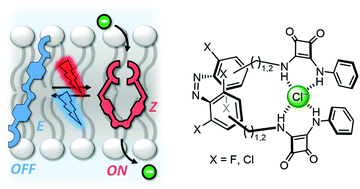Photo-responsive synthetic ion transporters are of interest as tools for studying transmembrane transport processes and have potential applications as targeted therapeutics, due to the possibility of spatiotemporal control and wavelength-dependent function. Here we report the synthesis of novel symmetric and non-symmetric red-shifted tetra-ortho-chloro- and tetra-ortho-fluoro azobenzenes, bearing pendant amine functionality. Functionalisation of the photo-switchable scaffolds with squaramide hydrogen bond donors enabled the preparation of a family of anion receptors, which act as photo-regulated transmembrane chloride transporters in response to green or red light. The subtle effects of chlorine/fluorine substitution, meta/para positioning of the anion receptors, and the use of more flexible linkers are explored. NMR titration experiments on the structurally diverse photo-switchable receptors reveal cooperative binding of chloride in the Z, but not E isomer, by the two squaramide binding sites. These results are supported by molecular dynamics simulations in explicit solvent and model membranes. We show that this intramolecular anion recognition leads to effective switching of transport activity in lipid bilayer membranes, in which optimal Z isomer activity is achieved using a combination of fluorine substitution and para-methylene spacer units.
